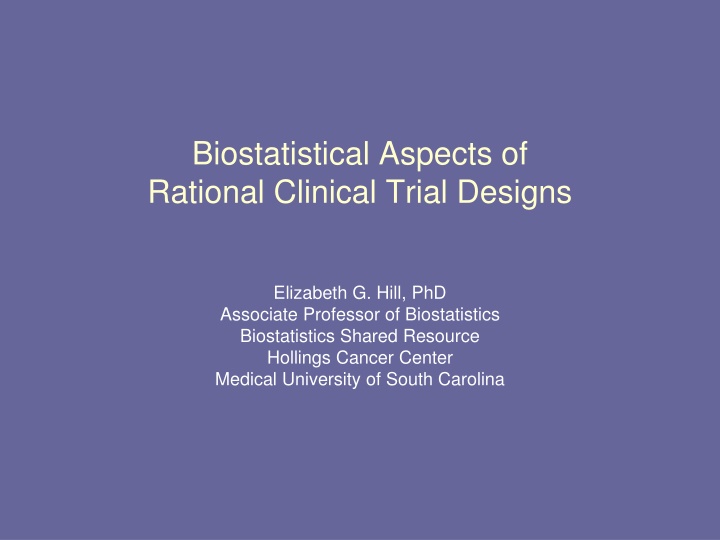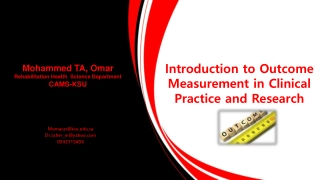
Biostatistical Aspects in Clinical Trials: Design, Phases, and Statistical Considerations
Explore the crucial aspects of biostatistics in clinical trial design, types of research studies in cancer, phases of drug development, and the importance of statistical design and development in clinical trials. Learn about writing clinical trial protocols, patient dose assignment, dose modifications, outcome measurements, data review for safety and efficacy, and where to find statisticians for collaboration. Ensure effective statistical considerations in your clinical research for successful trial outcomes.
Download Presentation

Please find below an Image/Link to download the presentation.
The content on the website is provided AS IS for your information and personal use only. It may not be sold, licensed, or shared on other websites without obtaining consent from the author. If you encounter any issues during the download, it is possible that the publisher has removed the file from their server.
You are allowed to download the files provided on this website for personal or commercial use, subject to the condition that they are used lawfully. All files are the property of their respective owners.
The content on the website is provided AS IS for your information and personal use only. It may not be sold, licensed, or shared on other websites without obtaining consent from the author.
E N D
Presentation Transcript
Biostatistical Aspects of Rational Clinical Trial Designs Elizabeth G. Hill, PhD Associate Professor of Biostatistics Biostatistics Shared Resource Hollings Cancer Center Medical University of South Carolina
Types of Research Studies in Cancer Basic Science Translational Clinical Exploratory/Pilot/Correlative Phase I Phase II Phase III Other: e.g. prevention, survivorship Epidemiological
Phases of Drug Development Phase I Dose finding Usually designed to find the highest safe dose. 12-30 patients Phase II Preliminary efficacy and safety Generally not head to head comparison 20-80 patients Phase III Definitive comparative trial against the standard of care Usually hundreds or thousands of patients
Clinical Trials: the beginning Write a clinical trial protocol Usually 70-180 pages Not like writing a grant Every detail spelled out: no page limit! There are standard templates that can/should be used.
Imagine. You are principal investigator (PI) of a clinical trial In the middle of the trial, you change careers You are now an astronaut and fly to the moon Meanwhile, a new patient is enrolled. The new PI needs to know: How should the patient be assigned to a dose? How should dose modifications occur? What measurements should be taken and when? What are the definition of the primary and 2ndary outcomes? Who and how are the data to be reviewed for safety and efficacy?
Statistical design and development of clinical trials Statistical considerations permeate the design and analytic plan Requires interaction with your statistician call early! before you have fixed the design bad: i have almost finished writing the protocol, and then i will send to you to insert a statistical plan Really, we are here to make your life easier
Where do I find this statistician? Academic cancer centers have biostatistics cores or biostatistics shared resources It is the role of these biostatisticians to help design clinical trials Find them! Other places: University settings usually have biostatistics departments or divisions Pharma will have biostatisticians on site or have biostatistical consultants available If your institution does NOT have biostats support, tell them they MUST HAVE IT!!!
Design of Clinical Trials: Striking a Balance Answer the question (correctly) Control risk of errors in conclusions Minimize potential harm and maximize potential benefit Limit number of participants treated at sub- therapeutic doses Limit number of participants treated with ineffective therapy or exposed to toxicity Maximize feasibility Make it simple enough to carry out Writing a detailed protocol can help avoid unforeseen feasibility issues
Statistical Considerations: 5 part process I. Stating research aims II. Determining your outcome measures III. Choosing the experimental design IV. The analytic plan V. Sample size justification
Motivating Example Phase II trial of induction gemcitabine/oxaliplatin/cetuximab (GOC) followed by intensity modulated radiotherapy (IMRT) with capecitabine to improve resectability in borderline and frankly unresectable pancreatic cancer Principal Investigator: Nestor Esnaola Single arm study Treatment plan: Patients are treated with GOC for six 14-day cycles. If resectable, taken to surgery If not, radiochemotherapy (IMRT + capecitabine (RCT)) and restaged
I. Stating research aims Authors devised a protocol, beginning with research aims Aims should be concrete and include measurable outcomes Bad examples: To evaluate the effect of GOC on cancer. To see if GOC + RCT improves cancer outcomes To determine the safety profile of GOC + RCT What is wrong with these aims? what does effect mean? what kind of cancer, in what patients? Improves compared to what? what is the outcome of interest? what does a safety profile mean? Think about how you are going to determine if this treatment approach works or not
I. Stating research aims Better examples: To evaluate the 6 month progression-free survival of GOC + RCT in patients with locally advanced, unresectable or borderline resectable, non- metastatic adenocarcinoma of the pancreas when treated with neoadjuvant GOC with or without RCT followed by definitive surgery. To determine the tolerance of this regimen, defined as the proportion of patients who follow the treatment plan. Keywords for primary outcome: determine, estimate, evaluate, describe efficacy, safety
Devising your aims Generally, there is ONE primary aim and your study is designed to address the primary aim Common (generic) aims per phase: Phase I: primary aim is finding the recommended dose Phase II: primary aim is determining if there is sufficient efficacy Phase III: primary aim is to determine which of two (or more) treatment combinations yields the longest overall survival Secondary aims: important, but do not drive the design pharmacokinetics pharmacodynamic (e.g., methylation) response safety change in gene expression
Aims and Hypotheses Aims are often accompanied by hypotheses. Stating the hypothesis to be tested can be a useful guide for the analytic plan: The 6 month PFS will be at least 70%
II. Determining your outcome measures The outcome measure will depend on the parameter of interest Examples of possible parameters of interest in phase II: response rate Median progression-free survival 6 month progression-free survival rate Synonyms: outcome, endpoints Aim endpoint What is an endpoint or outcome? patient-level measure of effect of interest measured on each patient in the study it is QUANTIFIABLE
Parameter of interest vs. outcome Parameter of interest Outcome Response rate: proportion of patients with CR or PR Median overall survival Response (CR or PR) Time from enrollment to death (or last follow-up) Time from enrollment to death (or last follow-up) Difference in quality of life scores from baseline to follow-up 6 month overall survival Mean change in quality of life
II. Determining your outcome measures Example: Parameter of interest is the 6 month progression- free survival rate Progression is objectively defined: the tumor has not increased by 20% or more comparing the baseline to the 6 month tumor measurement. Each patient is determined to either be or not be progression-free at 6 months. BINARY endpoint in this example
The following are NOT endpoints These are estimates of parameters: response rate median survival AE rate safety profile These describe the time course of the study in some way (don t let the term endpoint confuse you): length of time of treatment time until patient goes off-study length of study
Determining clinical outcomes: RECIST criteria Definitions of response, stable disease and progression are not quite as simple as they may seem in solid tumors RECIST: Response Evaluation Criteria in Solid Tumors. Version 1 is from 2000, Version 1.1 published in 2008. Key features: Definitions of minimum size of measureable lesions Instructions on how many lesions to follow Use of unidimensional measures for overall tumor burden See Eisenhauer et al., Eur J of Cancer (2009), 45, 228-247.
Definitions (briefly*) Complete Response: disappearance of all target lesions. Partial Response: at least a 30% decrease in the sum of the diameters of the target lesions, taking as a reference the baseline sum of diameters Progressive Disease: At least a 20% increase in the sum of diameters of target lesions. Increase must constitute at least 5mm absolute increase. Stable Disease: Shrinkage<30% or increase<20%. * based on target lesions and ignoring lymph node criteria for simplicity
III. Choosing the experimental design Based on the aims and the outcome, a design can be identified. Other considerations patient population accrual limitations previous experience with the treatment of interest in this or other populations results from earlier phase studies
III. Choosing the experimental design There are common approaches within each phase of drug development However, there are often many options and seemingly small details that can make big differences. Two common philosophies Frequentist Bayesian Buzzword: adaptive
Phase I trial goals Classic Phase I trials: Find the highest dose that is deemed safe: the Maximum Tolerated Dose (MTD) DLT = dose limiting toxicity Goal is to find the highest dose that has a DLT rate of x% or less (usually ranges from 20% to 40%) Newer Phase I trials: Find the dose that is considered to be safe and have optimal biologic/immunologic effect (OBD). Goal is to optimize biomarker response within safety constraints.
New paradigm: Targeted Therapy How do targeted therapies change the early phase drug development paradigm? Not all targeted therapies have toxicity Toxicity may not occur at all Toxicity may not increase with dose Targeted therapies may not reach the target of interest Implications for study design: Previous assumptions may not hold Does efficacy increase with dose? Endpoint may no longer be appropriate Should we be looking for the MTD? What good is phase I if the agent does not hit the target?
Phase II Provide preliminary information on whether a treatment is efficacious Provide preliminary data about the relationship between dose and efficacy. Often controlled but They are small: generally cannot find large differences in treatment effects Their endpoints are short-term Phase II endpoint: response Phase III endpoint: overall survival Often unblinded
GOC + RCT trial This is a single arm phase II trial to evaluate the 6 month PFS rate in patients with borderline and frankly unresectable pancreatic cancer. The goals: determine if the 6 month PFS rate is significantly better than 50%. Study design: A single arm, single stage study was designed The null hypothesis is that the 6 month PFS rate is 50% The alternative hypothesis is that the 6 month PFS rate is 70% Alternatives: Randomized phase II design Early stopping for futility (e.g. Simon two-stage).
Phase III If agent (or combination) succeeds in phase II, the next logical step is phase III. Usually designed by large companies or cooperative groups (e.g. ECOG, CALG-B). Comparative trial Two or more arms Standard outcome is overall survival (with rare exception in cancer) Goal: show a significant improvement in survival Generally very large and expensive Must be strong evidence in phase II to conclude that Phase III study will succeed
Phase III Very large undertaking Multicenter Infrastructure IRB and scientific approvals at each site Talks with FDA and other regulators Establishment of DSMB specifically for trials The statistical design is relatively simple compared to the practical issues of running a Phase III trial. Practical issues will often drive the design
IV. Analytic Plan Do you want to compare? Do you want to estimate? Do you want to test a hypothesis? These questions, in regards to your stated aims, will determine your analytic plan Recall primary aim: To determine the 6 month progression-free survival rate. Recall primary endpoint: 6 month progression- free survival indicator.
IV. Analytic Plan The analytic plan for the primary outcome usually involves two things: estimating a parameter of interest testing that the parameter is different than in another setting (e.g., different treatment) Estimation: a point estimate and some measure of precision Example: The 6 month PFS rate will be estimated with its confidence interval. this provides us with an estimate of the proportion of patients who are progression-free at 6 months. it also provides us with a measure of precision about the estimate
The 95% confidence interval an interval that contains the true value of the parameter of interest 95% of the time. we are 95% confident that the true 6 mo. PFS rate lies in this interval Example: below shows examples where observed rate is 0.50. 95% confidence interval width depends on the sample size Depending on the sample size, we have greater or less precision in our estimate 1.0 0.8 0.6 Proportion 0.4 0.2 0.0 20 40 60 80 100 120 140 160 180 200 Sam ple Size
IV. The analytic plan Hypothesis testing: Determining if the treatment is worthy of further study. Recall our hypotheses: The 6 month PFS rate of patients in this study will be at least 70%. What is a sufficiently LOW 6 month PFS rate that we are not interested in further pursuit? Based on the study team s experience, a 6 month PFS rate of 50% is too low to warrant further study of this treatment approach.
IV. Analytic Plan We perform a hypothesis test: Ho: p = 0.50 (null) Ha: p = 0.70 (alternative) This test is performed using an exact binomial procedure. The result is a p-value that provides evidence to either reject or fail to reject the null hypothesis If this were a randomized phase II study: the test is performed in each arm the arms are not directly compared to one another (that is a different test)
Recall the p-value p-value: the probability of observing a result as or more extreme than we saw in our study if the null hypothesis is true. Small p-value: evidence that the null is not true ( significant result ) Large p-value: not sufficient evidence to reject the null ( not signficant ) Threshold for significance? we usually think of 0.05, but in phase II, often use 0.10.
IV. Analytic Plan Depends on the design and the goals Example is a Phase II trial single arm approach to analysis compare to historical 6 month PFS rate (e.g., 0.50) Phase I studies often the analysis plan is descriptive rare to see hypothesis testing (for primary aim) Phase III studies head to head comparison of groups Hazard ratio compares event rates per group Time to event methods are required: Log rank test Cox regression
V. Sample size justification Two basic approaches power (most common) precision Recall: Limit number of participants treated at sub-therapeutic doses Limit number of participants treated with ineffective therapy or exposed to toxicity But, also we need to enroll enough patients to achieve our aims Balancing act: Too few patients: you cannot answer the question Too many patients: you have wasted resources and potentially exposed patients to an ineffective treatment unnecessarily Most commonly motivate sample size by a hypothesis testing approach
Refresher of alpha, beta and power Ho is True Ho is NOT True Type II error Accept Ho Reject Ho Type I error =probability of Type I error (level of significance) =probability of Type II error 1- =Power
Plug and Chug With power of 80% and one-sided alpha of 0.05, and Ho and Ha, a one-stage design was selected. A single stage design was chosen. To achieve a power of 80% with a one-sided alpha assuming a null 6 month PFS of 50% and an alternative rate of 70%, 39 patients need to be enrolled. If 25 or more of the patients are progression-free at their 6-month visit, then we will reject the null hypothesis at the 5% level and conclude that the treatment approach is worthy of further study.
Plug and Chug with interim look With power of 80% and one-sided alpha of 0.05, and Ho and Ha, a Simon two-stage design could have been adopted. The Simon s two stage design used is defined as follows. Our null hypothesis is that the 6 month PFS rate is 50% and our alternative hypothesis is that it is 70%. At the first stage we will enroll 15 patients. We will close accrual to an arm if < 8 patients are PF at 6 months. If 9 or more are progression-free at 6 months, then the study will remain open for an additional 28 patients. The treatment approach will be considered promising if at least 27 patients are progression-free in 43 patients. This study has power of 80% and a one-sided alpha of 5%. The sample size per arm will be 15 patients or 43 patients (depending on early stopping)
V. Sample size justification Hypothesis testing is not always the way to go Sometimes estimation is sufficient (but not always! it is not an escape route ) In that case, sample size can be justified by precision Example: with 39 patients, we will be able to estimate the 6 month PFS rate with a 90% confidence interval with half-width no greater than 0.16. Difficult part: is 0.16 half-width sufficiently precise? how to rationalize that?
Sample size is generally chosen based on 1. budget 2. expected accrual 3. the clinical effect size of interest 4. type I and type II errors 5. 3 and 4 6. all of the above
Feedback loop The process is actually not completely linear as stated Examples: Design issues may cause you to change your outcome or restate your aim Accrual limitations may cause you to change the design Dynamic process
Additional aims (correlatives, etc.) VERY important aims! Not discussed here due to space/time. Same principles apply for stating aims, determining outcomes, writing analytic plan Usually power/sample size is less of a concern for secondary aims correlative does not mean you can be vague! these need to be well-conceived often on biopsy tissue, pre post design will you really learn anything?
Early Stopping Rules and Interim Analyses As a general rule, consider incorporating early stopping rules Why? Ethics and resources Lots of reasons for stopping Example: phase II designs Early stopping for safety (one or more arms) Early stopping for futility Early stopping for harm
Implications of early/interim looks Early looks can/will affect Type I error Type II error Consequences? They need to be built into study design and power calculations Misconception: The DSMB will stop the study early if needed for safety or harm so there is no need to account for early looks. Having independent review does not mean that the interim looks should not be built in to design.
Data Safety Monitoring Board/Committee DSMB or DSMC Standard in phase III trials. Independent body of experts, usually clinical researchers + 1 or more statisticians + an ethicist. They periodically review ongoing trial results Have access to unblinded treatment assignments if necessary. Often assumed they will do more than they should (e.g. redesign the study in midstream)
Take-home points Talk to your statistician early and often when you want to design a study Write clear aims and define clear endpoints Let the statistician help you with the design, analysis plan and power calculation: that is our job. How to learn more? Visit your institution s cancer protocol review committee Try a workshop (check out AACR workshop schedule)
Some good text books on trials General Trials: Clinical Trials: A Methodologic Perspective (Piantadosi) Clinical Trials (Meinert) Specific to Cancer: Classic: Clinical Trials in Oncology (Green, Crowley, Benedetti and Smith) Recently published Principles of Anti-Cancer Drug Development (Hidalgo, Eckhardt, Garrett-Mayer, Clendenin) Oncology Clinical Trials: Successful Design, Conduct, and Analysis (Kelly, Halabi, Schilsky)









